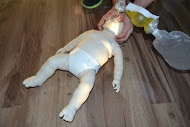Heart disease in children

In the US alone, over 235 deaths per 100,000 were attributed to cardiovascular disease in 2010. Though these rates had declined by 31 percent since the last report, that still means that CVD accounted for almost 32 percent of the total number of deaths, a statistic that rounds up to 1 out of 3 deaths in the country. While majority of this percentage are adults, a percentage of that amount is still children. While there is no mandatory or official registry for pediatric SCA (sudden cardiac arrest), the CDC estimates that approximately 2000 people younger than 25 years old will die of SCA. Based on these studies, the number of children who die each year due to a cardiac related problem is actually increasing.
Respiratory and cardiovascular failure
Children make up a very small percentage of people who get heart attacks each year in the US. However, mortality rates for pediatric victims are extremely high, because their heart attacks are at the end of a cascading set of symptoms that stem from respiratory problems. By this, it means that whenever a child experiences cardiac arrest, it is most commonly caused by respiratory failure. When the child cannot breathe, it increases the stress placed on the heart, triggering a heart attack. It becomes much more difficult to resuscitate a child because both the respiratory and cardiovascular systems are failing or have failed.
CPR in children
When CPR is given to children, there are a few differences, primarily in compression depth and priority. The compression rate is the same for adults and children, 1 cycle equals to 30 compressions and 2 rescue breaths. Compression depth for adults is at least 2 inches while the depth for children is between 1.5 inches and 2 inches. When it comes to priority, compressions are always first when giving CPR to an adult. However, because cardiac arrest in children is primarily due to a respiratory problem, both compressions and ventilation are of equal priority. This is why establishing a patent airway in children is very important.
PALS training
Pediatric Advanced Life Support (PALS) is an advanced training program for health care providers. It is a long program, running for 16 hours over two days. The program’s curriculum is focused on giving advanced training to HCPs about medical management of pediatric victims, including:
- Cardiac medication commonly given to children and pediatric dosages
- Using and setting up ventilatory equipment
- Endotracheal tube insertion
- Electrocardigram (ECG) reading
Because it falls under Advanced Life Support (ALS) training, we require all our students to have a valid Basic Life Support (BLS) certificate before they can enroll in the program. There is also a pre-test that they need to pass before continuing. After they complete the PALS program and pass the certification exam as well, they are awarded a 2-year valid PALS certificate. This certificate is a common requirement if you want to work in a hospital or similar health care institution.
